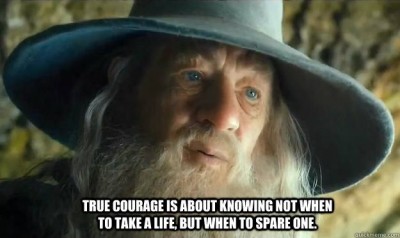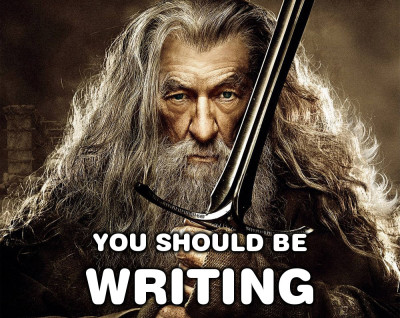“End? No, the journey doesn’t end here!“ by Tomas Aleknavičius

Many know J. R. R. Tolkien as the writer of “The Lord of the Rings”.
 Do all know that he did not begin, nor stop with this novel? Many don’t bother to wander that maybe there is more of the Middle-Earth they learned to love so much just waiting to be discovered. “The Lord of the Rings” was written in 17 years. Tolkien polished his story relentlessly so it would fit his grand design.
Do all know that he did not begin, nor stop with this novel? Many don’t bother to wander that maybe there is more of the Middle-Earth they learned to love so much just waiting to be discovered. “The Lord of the Rings” was written in 17 years. Tolkien polished his story relentlessly so it would fit his grand design.  What is even more remarkable is that the action of the novel takes place at the end of the Third Age of Middle-Earth history. By the way – ages in Tolkien’s writing are periods of time defined by major events such as cataclysms or great shifts of political power. So, how about the Ages that come before? What about those that come after? These would be very good questions to ask. And Tolkien answers. He answers with the totality of all of his life’s work. He gives you “The Silmarillion”. It is a collection of stories that were published after his death
What is even more remarkable is that the action of the novel takes place at the end of the Third Age of Middle-Earth history. By the way – ages in Tolkien’s writing are periods of time defined by major events such as cataclysms or great shifts of political power. So, how about the Ages that come before? What about those that come after? These would be very good questions to ask. And Tolkien answers. He answers with the totality of all of his life’s work. He gives you “The Silmarillion”. It is a collection of stories that were published after his death in 1977 by his son, Christopher Tolkien. Tolkien, the elder, began writing the stories that would later become “The Silmarillion” back in 1914.
in 1977 by his son, Christopher Tolkien. Tolkien, the elder, began writing the stories that would later become “The Silmarillion” back in 1914.  He intended them to become an English mythology that would explain the origins of English history and culture. As a scholar of mythopoeic literature he wanted to give his people something that he thought they, as a nation, were deprived of. Although “The Silmarillion” was rejected by publishers over and over again,
He intended them to become an English mythology that would explain the origins of English history and culture. As a scholar of mythopoeic literature he wanted to give his people something that he thought they, as a nation, were deprived of. Although “The Silmarillion” was rejected by publishers over and over again, Tolkien never gave up. As relentlessly as he cared for every detail in his works, so too, he wrote to editors and publishers seeking those that would take “The Silmarillion” out into the world. Encouraged by the success of “The Hobbit” he tried once more, but it was not yet his time. After this last attempt he returned to puffing his pipe and polishing the philosophy and the theology of Middle-Earth to the very end of his life. Several years after Tolkien’s passing, his son, Christopher, edited and compiled the narrative that is now known as “The Silmarillion”. Finnaly in the fall of 1977 the greatest work of J. R. R. Tolkien was published.
Tolkien never gave up. As relentlessly as he cared for every detail in his works, so too, he wrote to editors and publishers seeking those that would take “The Silmarillion” out into the world. Encouraged by the success of “The Hobbit” he tried once more, but it was not yet his time. After this last attempt he returned to puffing his pipe and polishing the philosophy and the theology of Middle-Earth to the very end of his life. Several years after Tolkien’s passing, his son, Christopher, edited and compiled the narrative that is now known as “The Silmarillion”. Finnaly in the fall of 1977 the greatest work of J. R. R. Tolkien was published.
“The Silmarillion” is compiled of five parts:
#gallery-1 { margin: auto; } #gallery-1 .gallery-item { float: left; margin-top: 10px; text-align: center; width: 100%; } #gallery-1 img { border: 2px solid #cfcfcf; } #gallery-1 .gallery-caption { margin-left: 0; } /* see gallery_shortcode() in wp-includes/media.php */
- 1.Ainulindale (The Music of the Ainur) and Valaquenta– speaks about the creation of the Middle- Earth (A.) and accounts all of the Valar, the Gods of Middle-Earth (V.);
#gallery-2 { margin: auto; } #gallery-2 .gallery-item { float: left; margin-top: 10px; text-align: center; width: 50%; } #gallery-2 img { border: 2px solid #cfcfcf; } #gallery-2 .gallery-caption { margin-left: 0; } /* see gallery_shortcode() in wp-includes/media.php */
- 2.Quenta Silmarillion – the history of the Silmarils and the war of the Noldor (elves) against Morgoth (The First Enemy);
- 2.1 Of Beren and Luthien – the greatest love story Middle-Earth has ever seen;
- 2.2 Turin Turambar – the legend also known as “The Children of Hurin”. One of the saddest tragedies written by Tolkien;
- 2.3 Of Tuor and the Fall of Gondolin – the story of the hidden city of Gondolin and its fate;
#gallery-3 { margin: auto; } #gallery-3 .gallery-item { float: left; margin-top: 10px; text-align: center; width: 50%; } #gallery-3 img { border: 2px solid #cfcfcf; } #gallery-3 .gallery-caption { margin-left: 0; } /* see gallery_shortcode() in wp-includes/media.php */
- 2.4 Of the Voyage of Earendil and the War of Wrath – the last story of the First age of Middle-Earth;
- 3.Alkallabeth (The Downfallen) – talks about the Second Age and the kingdom of Numenor;
4. Of the Rings of Power and the Third Age – or “The Lord of the Rings”.
After the end of the Third Age comes the Fourth Age or the Age of Man, where the Middle-Earth gradually becomes more and more like our Earth, but Tolkien never wrote down more than an obscure definition of the Ages to come. Instead, he left us with “The Silmarillion”. A grand adventure spanning over thousands of years “The Silmarillion” accounts for the fall of the Melkor, the First Enemy, the downfall of Numenor, the greatest kingdom of Men, the retreat of the Elves and the Valar from the everyday lives of men.
becomes more and more like our Earth, but Tolkien never wrote down more than an obscure definition of the Ages to come. Instead, he left us with “The Silmarillion”. A grand adventure spanning over thousands of years “The Silmarillion” accounts for the fall of the Melkor, the First Enemy, the downfall of Numenor, the greatest kingdom of Men, the retreat of the Elves and the Valar from the everyday lives of men.
I have given you, dear reader, a glimpse of what Tolkien worked on, his entire life. Short and clouded as it may have been, still you might have caught the idea or should I say the reason why I write about this man. What he has accomplished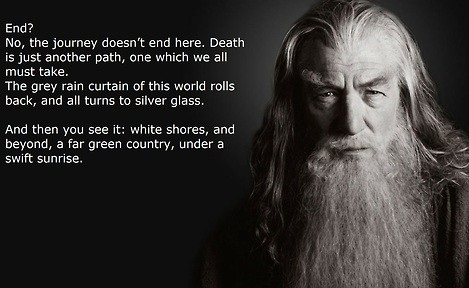 surpasses many of his peers, not to mention followers. Single handedly this man has created a mythological background, languages, cultures, histories that encompass as much as some of our own, real world traditions. One man, in ~60 years has done something that nations work on for centuries. And we have the opportunity to see it, read it for ourselves. Isn’t that amazing? With this in mind, I invite you to journey through the First and Second Ages of Middle-Earth in the next series of articles. I will talk about each of the legends separately and the themes that join them thus forming the underlying base of values and beliefs upon which Middle-Earth is built.
surpasses many of his peers, not to mention followers. Single handedly this man has created a mythological background, languages, cultures, histories that encompass as much as some of our own, real world traditions. One man, in ~60 years has done something that nations work on for centuries. And we have the opportunity to see it, read it for ourselves. Isn’t that amazing? With this in mind, I invite you to journey through the First and Second Ages of Middle-Earth in the next series of articles. I will talk about each of the legends separately and the themes that join them thus forming the underlying base of values and beliefs upon which Middle-Earth is built.
#gallery-4 { margin: auto; } #gallery-4 .gallery-item { float: left; margin-top: 10px; text-align: center; width: 100%; } #gallery-4 img { border: 2px solid #cfcfcf; } #gallery-4 .gallery-caption { margin-left: 0; } /* see gallery_shortcode() in wp-includes/media.php */

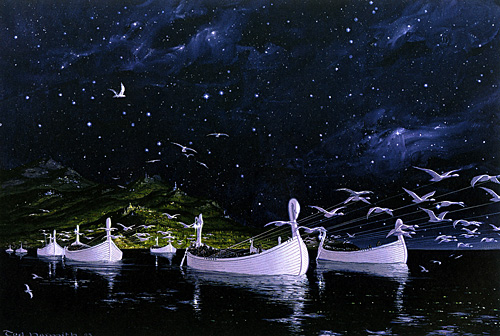








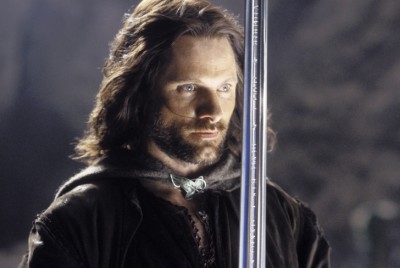
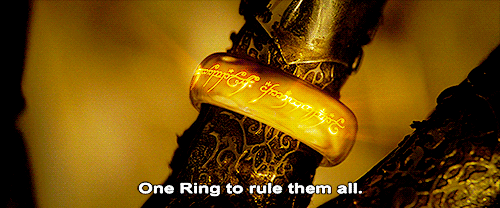

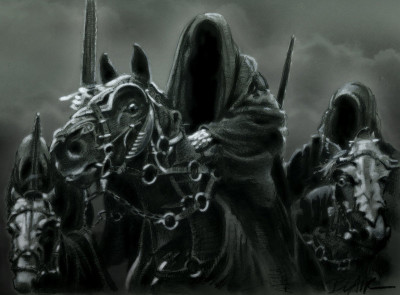
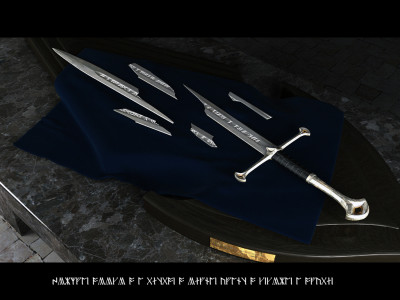



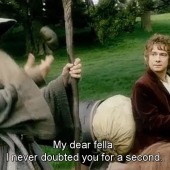 sang Frodo to himself while wandering about the Shire. These words delicately describe the fragile wanting of every hobbit to
sang Frodo to himself while wandering about the Shire. These words delicately describe the fragile wanting of every hobbit to explore, experience and discover. Yet, that wish remains contained. Mostly, by the greenhouse like conditions of the Shire. Only a handful dared to step further than any hobbit before and… a little bit further.
explore, experience and discover. Yet, that wish remains contained. Mostly, by the greenhouse like conditions of the Shire. Only a handful dared to step further than any hobbit before and… a little bit further. not strong enough. Because they had no powers, no great weapons. Because they dared to take that one little step further. Their journey was long. Their road went far. So far, down from the door where it began…
not strong enough. Because they had no powers, no great weapons. Because they dared to take that one little step further. Their journey was long. Their road went far. So far, down from the door where it began…

 minds and decide to enter Mordor through a “back door”, so to speak. Here I will stop, so not to spoil any more important details, for possible future readers.
minds and decide to enter Mordor through a “back door”, so to speak. Here I will stop, so not to spoil any more important details, for possible future readers.
 “I found it is the small everyday deeds of ordinary folk that keep the darkness at bay, small acts of kindness and love. – Gandalf “.
“I found it is the small everyday deeds of ordinary folk that keep the darkness at bay, small acts of kindness and love. – Gandalf “.